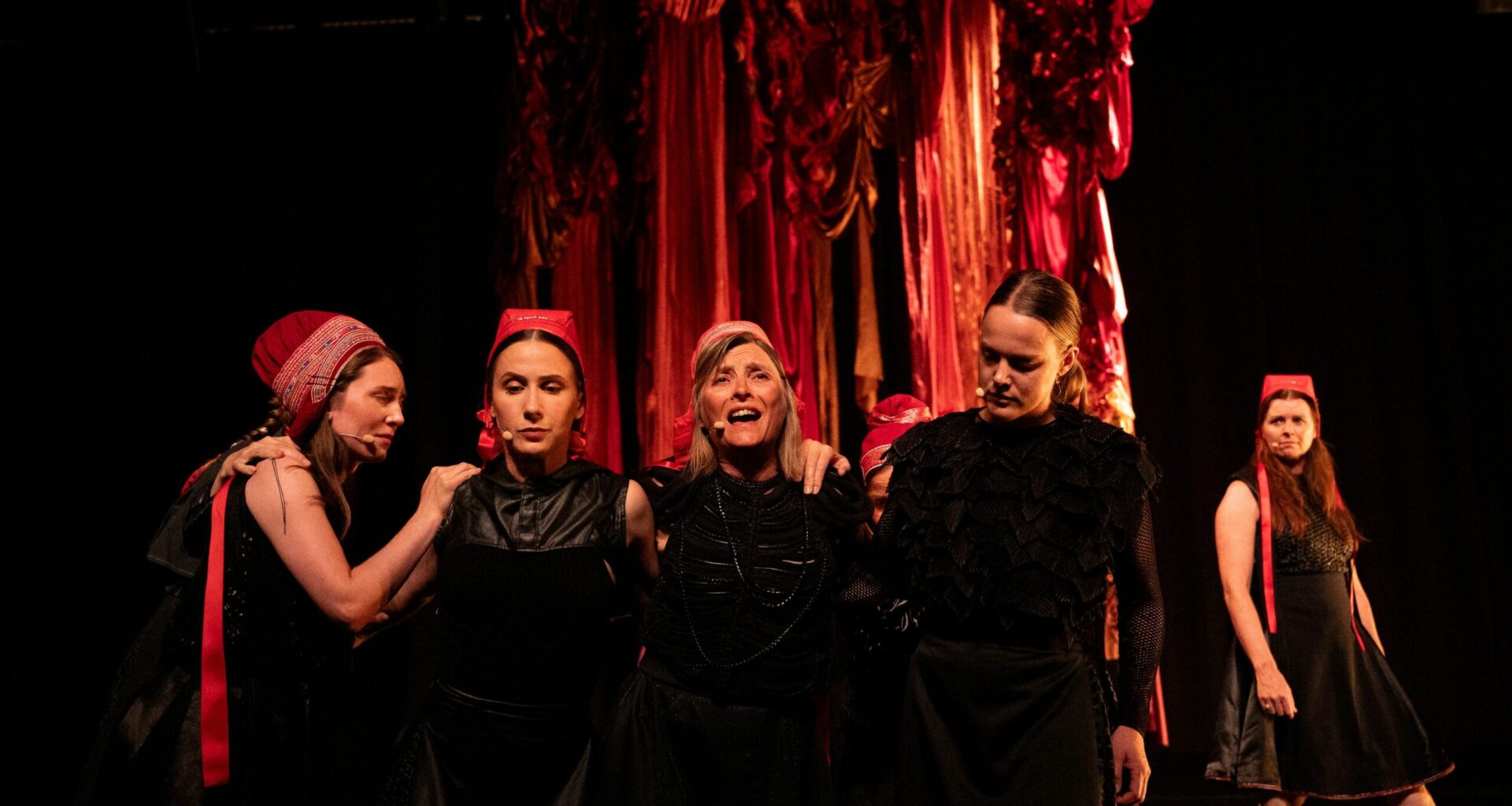On Wednesday of this past week, I saw a Cambodian dance performance at Jacob’s Pillow. The next day, Thursday, I saw Elle Sofe Company from Norway. And that was just the two days this week that I happened to be at the Pillow. Pillow founder Ted Shawn was famous for bringing dance from all over the world to his renowned venue in the rural Berkshire hills. Shawn’s legacy clearly lives on.
On Thursday, Sofe’s Norwegian company performed in The Doris Duke Theatre. Or actually, I should say the performance ended in The Duke. It started on a lawn at the Pillow’s entrance, with audience members in a large circle. The performers, seven women (the program lists some as “singers” and some as “dancers,” but this viewer, probably wrongly, experienced all of them as both), entered the circle holding bullhorns over their heads and proceeded to do a gentle, ceremonial dance inside the circle. At some point during this opening, the performers began singing. More on the extraordinary music and the singing later.
The performers then exited the circle just as they had entered, and the rest of us, like lemmings, silently followed them. The performers were so self-assured and commanding that I am sure, like lemmings, we would have followed them off a cliff if that is what they had asked us to do. Instead, we moved along the paths at the Pillow and were taken into The Duke through the back, deliberately walking right past the main theater entrances on the way. We entered the theater via the backstage, requiring us to walk on the stage itself to get to the house, where we all quietly and obediently took seats. In a simple way, it seemed Sofe was attempting to demystify the performance, lessen its formality, and diminish the power of the “fourth wall.”
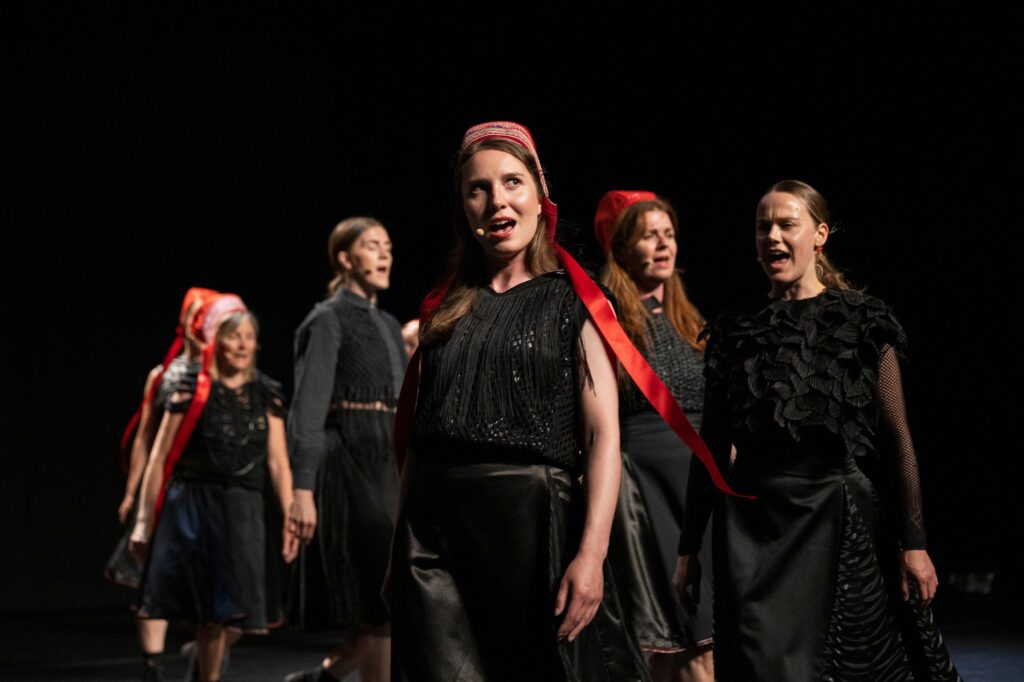 Emma Elliane Oskal Valkeapää in “vástádus eana — the answer is land” by Elle Sofe Company at Jacob’s Pillow. Photo by Jamie Kraus.
Emma Elliane Oskal Valkeapää in “vástádus eana — the answer is land” by Elle Sofe Company at Jacob’s Pillow. Photo by Jamie Kraus.
Sofe is both Norwegian and Sámi, as are all seven women performers in the work. According to the excellent “Pillow Notes” in the program, written by Cathy Levy, the Sámi culture is nomadic (the people apparently borrow a place for a time) and is indigenous to northern Sweden, Norway, and Finland, as well as parts of Russia. The piece the company performed at the Pillow, “vástádus eana — the answer is land,” was inspired by a poem about the Sámi people’s strength and resilience notwithstanding centuries of forced assimilation and colonialism. (That story should sound familiar to anyone living in the United States.) The work is about a desire to reconnect with the land, but, poignantly, also explores trauma, abuse, pain, and suicide.
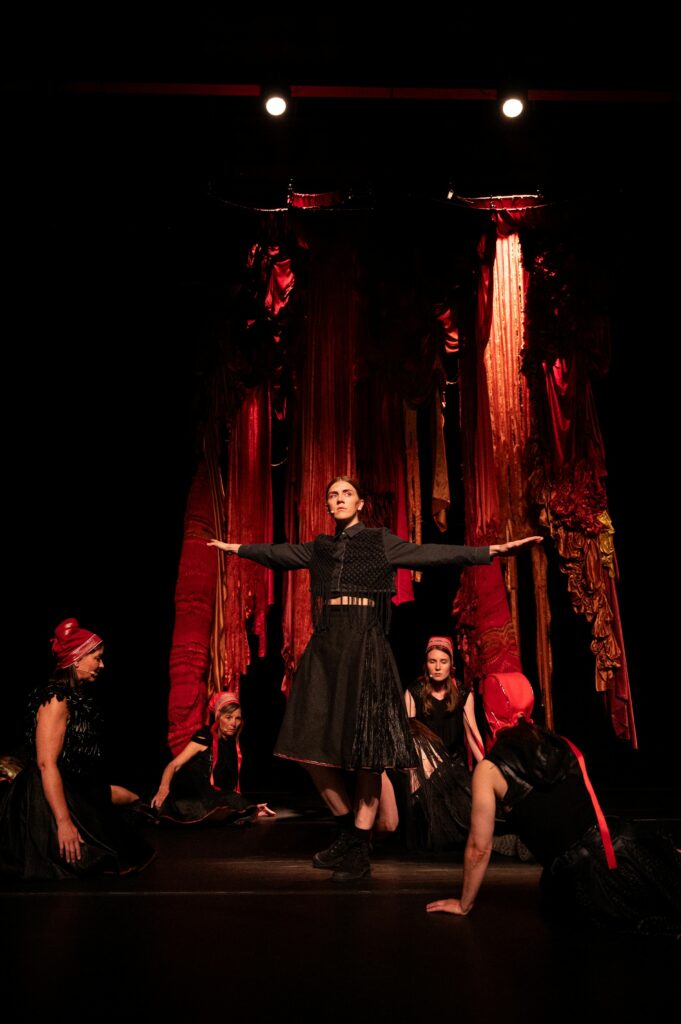 Emilie Marie Karlsen in “vástádus eana — the answer is land” by Elle Sofe Company at Jacob’s Pillow. Photo by Grace Copeland.
Emilie Marie Karlsen in “vástádus eana — the answer is land” by Elle Sofe Company at Jacob’s Pillow. Photo by Grace Copeland.
The piece was incredibly deliberate, unfolding very, very slowly and in a measured way. There were periods of silence, with very little movement, but with a distinctive kind of drama. After one sustained stillness, one of the performers fell over as if she was a tree crashing down, and all the others startled, like animals in a forest. Then they came to her aid, a theme throughout as the work developed: the performers aiding, comforting, and assisting each other, and also seemingly preventing one another from hurting themselves. It seemed to this viewer that the piece began with all seven performers in a kind of isolation, and, by the end, they were all intimately connected and supporting each other. Emilie Marie Karlsen, who struggled the most within the piece, seemed to be the principal catalyst for this noteworthy transformation.
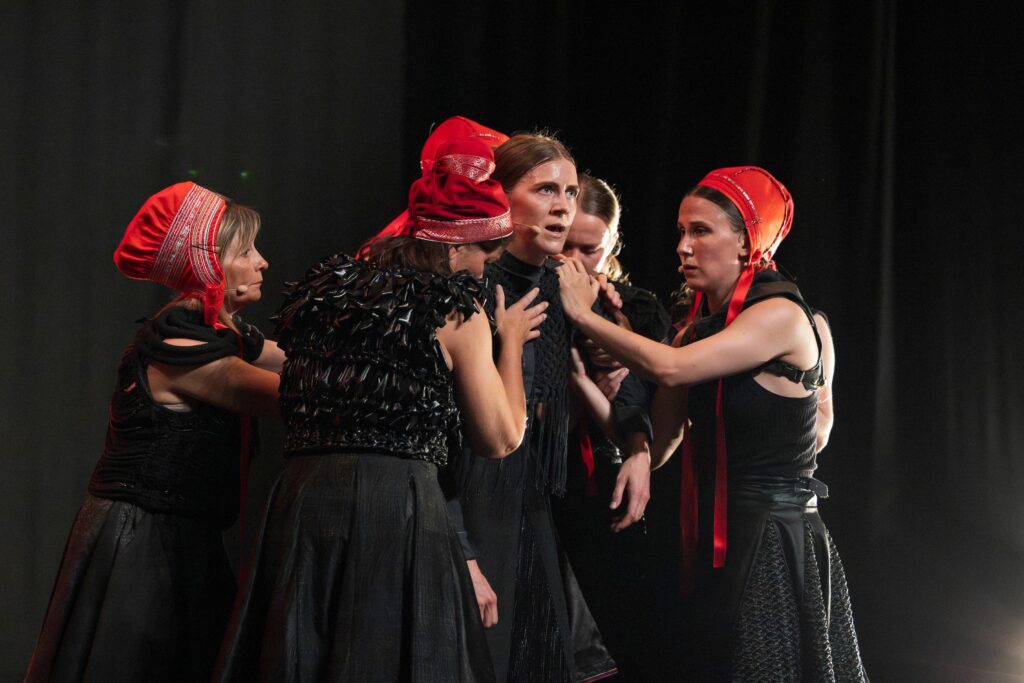 Emilie Marie Karlsen in “vástádus eana — the answer is land” by Elle Sofe Company at Jacob’s Pillow. Photo by Jamie Kraus.
Emilie Marie Karlsen in “vástádus eana — the answer is land” by Elle Sofe Company at Jacob’s Pillow. Photo by Jamie Kraus.
The piece was a reminder, as were the Cambodian dance I had seen the evening before and the many other diverse performances I have seen at the Pillow and elsewhere over the years, of just how different the human experience is, and the creative process is, depending on where you live and where your culture and history come from. This work had a sensibility unlike any other I had ever experienced.
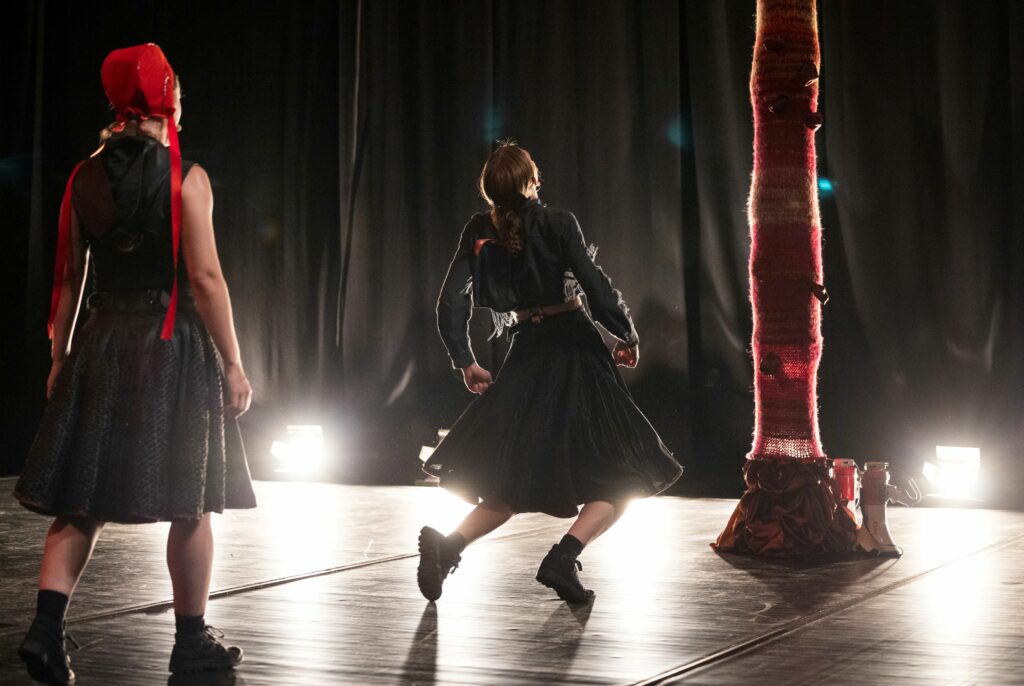 “vástádus eana — the answer is land” by Elle Sofe Company at Jacob’s Pillow. Photo by Jamie Kraus.
“vástádus eana — the answer is land” by Elle Sofe Company at Jacob’s Pillow. Photo by Jamie Kraus.
Yet, at the same time, there was a familiar—and comforting—universality to the performance as well. The dance forms and patterns were recognizable: arms outstretched or overhead, performers running in circles, performers in lines or in circles, and, most definitely, the foot stomping and the rhythms connected thereto. The foot stomping was reminiscent not only of Irish step dancing, of course, and of tap, but also of the czardas and the mazurka and many other indigenous, as well as “folk,” dances from around the globe.
This universality was most apparent, however, in the music, which was astonishing. “vástádus eana — the answer is land” utilized a Sámi traditional mountain song form called a yoik. Sámi composer Frode Fjellheim composed the music and, although traditionally the songs are sung solo, Fjellheim composed for multiple voices, blending traditional and contemporary polyphonic yoiks. While Fjellheim’s wonderful music was completely distinctive and unique, it was also somehow reminiscent of Gregorian chants, of American acapella folk music from Appalachia, of the Chicago blues, of electronic synthesizers, of modern minimalist music, and much more. And it was exquisitely delivered by the singers, with subtlety, nuance, and incredible power. These singers had amazing voices, and they worked together superbly.
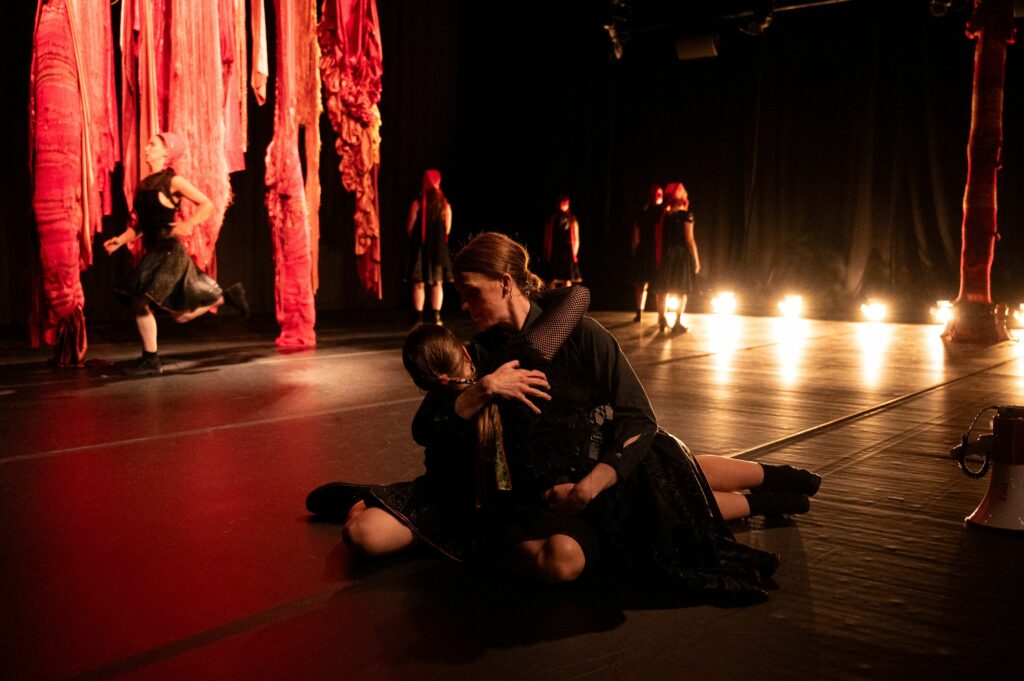 “vástádus eana — the answer is land” by Elle Sofe Company at Jacob’s Pillow. Photo by Grace Copeland.
“vástádus eana — the answer is land” by Elle Sofe Company at Jacob’s Pillow. Photo by Grace Copeland.
“vástádus eana — the answer is land” by the Elle Sofe Company reminds us of just how very similar all our experiences as human beings on this planet are, even though they often seem so vastly different. It is an incredibly valuable lesson. A schedule of the Sofe performances, as well as listings of all the performances and activities at the Pillow this summer, can be found on the Jacob’s Pillow website.
